(VOVWORLD) - The Hung Temple's bronze drum, the largest bronze drum in Vietnam and in Southeast Asia, is one of Vietnam’s renowned Dong Son bronze drums, a sacred symbol of the Vietnamese people.
The Hung Temple's bronze drum, aka the Hy Cuong bronze drum, was found in 1990 in Co Tich Village, 500 meters from Hung Mountain in the northern Phu Tho province. It is the largest bronze drum in Vietnam and in Southeast Asia - 93 cm in diameter and 70 cm in height. The drum, which is said to date back to between 3 BC and 1 AD, is now at Hung Temple in Phu Tho province. The temple is dedicated to the Hung Kings, the legendary founders of the Vietnamese nation 4,000 years ago.
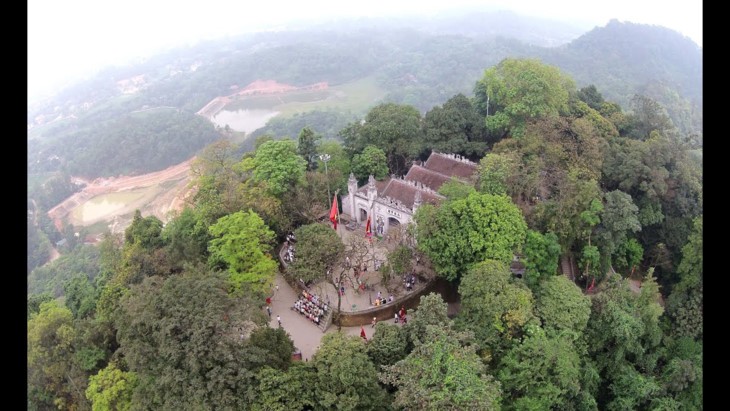 Hung Kings Temple is located on Nghia Linh mountain, Viet Tri city, Phu Tho province. (Photo: VNA) Hung Kings Temple is located on Nghia Linh mountain, Viet Tri city, Phu Tho province. (Photo: VNA) |
“This bronze drum at our museum is unique. It’s a national treasure. One iconic image found on its top is a classic 'starburst', with a number of spikes radiating out from a center. This image is recognizable as a representation of the sun. There are also small three-dimensional animals or toads among other common designs such as bird motifs and geometric symbols. All of these designs represent wet rice civilization, the sun being considered the most powerful Genie, followed by the people, the land, and the water,” said Nguyen Thi Van Anh, an employee at the Hung Kings' Temple.
|
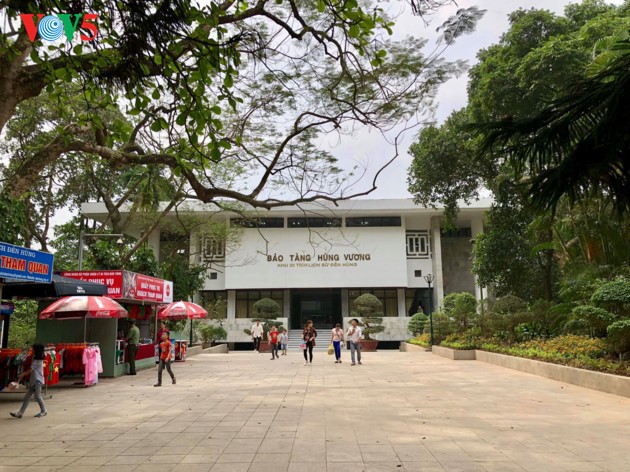
The Hung Kings museum embodies Vietnam’s glorious history.
|
The Hung Temple’s drum is one of several Dong Son drums found in Vietnam. The Dong Son drum is the most famous artifact of the Southeast Asian Dong Son culture, a complex society of farmers and sailors who lived in what is today northern Vietnam and made bronze and iron objects between 600 BC and AD 200.
The drums, which have been found throughout Southeast Asia, can be enormous - a typical drum is 70 centimeters in diameter - with a flat top, bulbous rim, straight sides, and a splayed foot. The first archaeologist to comprehensively study southeast Asian drums was Franz Heger, an Austrian archaeologist, who categorized the drums into four types and three transitory types. Heger's Type 1 was the earliest form, and that is the one called the Dong Son drum.
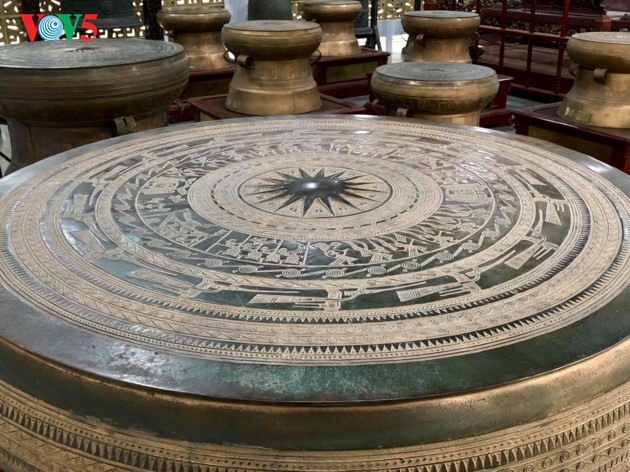 Bronze drums on display inside the Hung Kings museum. Bronze drums on display inside the Hung Kings museum. |
“Bronze drums created in the Hung Kings’ culture were not only musical instruments but also weapons and sacred items, bearing with them all the typical cultural characteristics of that historical period. Designs on the surface and body of the drums represent the people’s respect for the Sun, and their wishes for peace, favorable weather, and bumper crops. People displayed their communal strength by beating the drums on the battlefield to encourage their soldiers," said Nguyen Thi Nhan, a curator at the Hung Kings’ Museum.
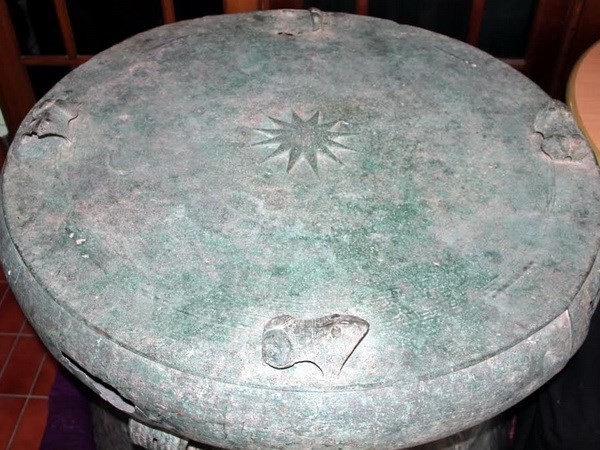 The surface of a Dong Son bronze drum (Source: VNA) The surface of a Dong Son bronze drum (Source: VNA) |
The Dong Son bronze drum is a product of the excellent bronze-casting technique of the ancient Viet people. Hundreds of terra–cotta and stone molds have been discovered in ancient Viet villages and graves of the same era. In the area of the Dong Son culture, many artifacts have been found, and bronze artifacts are more abundant than iron ones.
The large bronze drums were cast using very skilled techniques which experts believe to be the lost-wax casting method. It is the process by which a duplicate metal sculpture is cast from an original sculpture. We cannot today produce such perfect drums using traditional casting methods.
There is evidence suggesting that the ancient Viet people used the drums when they were alive and were buried with the drums when they died. The bronze drums found in Vietnam are quite different from the bronze drums of the Tian culture in Yunnan, China, from the same era. There are differences in shape and decorative designs, according to Associate Professor Trinh Sinh, an archaeologist who has spent years researching Dong Son bronze drums.
“The beauty of Dong Son bronze drums lies in their representation of our early states and wet rice cultivation. The drums were created by Dong Son people and are said to depict their spiritual and powerful symbols,” said Mr. Sinh.
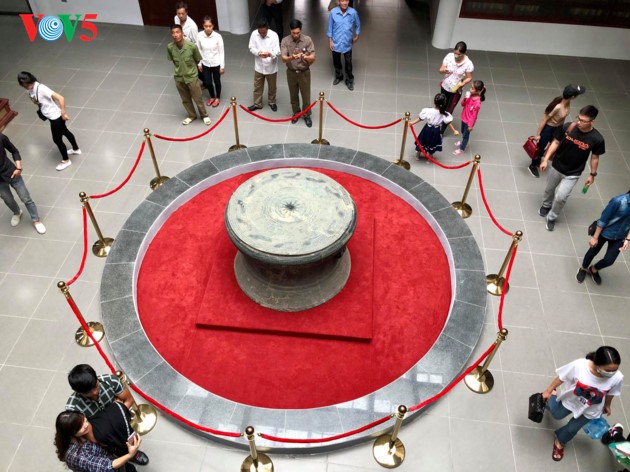 The Dong Son boat pattern on bronze drums reflects the most important means of transportation during the Hung Kings period. The Dong Son boat pattern on bronze drums reflects the most important means of transportation during the Hung Kings period. |
The Hung Temple’s bronze drum is considered an artwork, meticulously carved with complicated flower patterns, and represents the people’s concepts of nature and life during the Hung Kings’ periods.
“Dong Son bronze drums are wonderful products of our ancestors, who were skilled metallurgists living in the Hung Kings’ periods. Long-beaked and long-tailed birds with outstretched wings are often seen on the drums, and interpreted as typically aquatic, such as herons or cranes. Other designs in the shape of animals also appear on the drums. Bronze drums were created not only for music but also to show off the power of the tribal leaders,” said archaeologist Pham Van Tuan.
Ms. Nguyen Thi Van Anh from the Hung Kings’ Museum explains the 4 small three-dimensional toads that appear symmetrically on the drum: “For ancient Vietnamese people, the toad was more powerful than the King of Heaven. Legend has it that when you hear the toad croak, you know rain will come down soon. During droughts, the ancient Vietnamese people often beat their bronze drums in the hope that rain would come down soon so they could drink, bathe, and water their crops.”
According to Dr. Pham Van Tuan, the ancient Vietnamese people reflected their interpretation of everything in the world in their bronze drums.
“Designs on the bronze drums depict the ancient people’s sense of beauty and aspirations. The sun symbol represents wishes for favourable weather, and the long-tailed birds turned towards the ancestral land reflect the Dong Son people’s economic and spiritual life around 2,000 years ago,” said Dr. Tuan.
The custom of beating bronze drums has recently been revitalized as an indispensable part of activities to mark the Hung Kings’ death anniversary on the 10th day of the third lunar month.
The Dong Son culture ranks among the great bronze cultures of the world, and its creators were the ancestors of the Vietnamese.
The Dong Son drum is a symbol of the ancient civilization of Vietnam. They have been called ‘‘the key to understanding Dong Son culture and thus the spirit of Vietnam”.